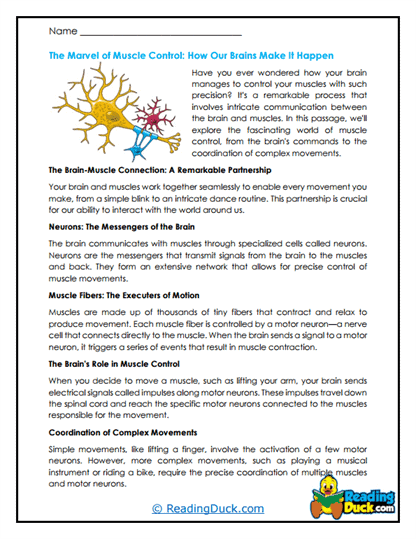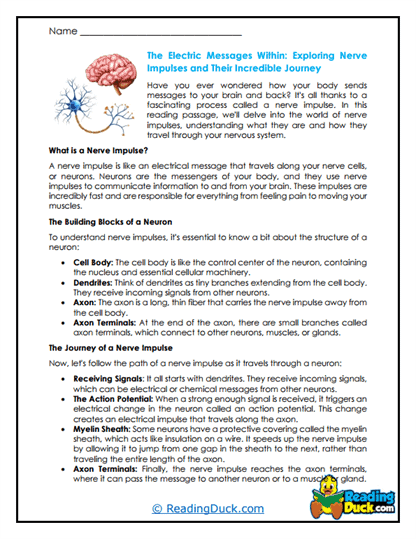Nervous System Worksheets
About Our Nervous System Worksheets
Our Nervous System worksheets offer an engaging and detailed exploration of one of the most complex and essential systems in the human body. As a subtopic under the broader category of the Human Body in Science: Biology, this collection delves into the anatomy, function, and importance of the nervous system. The worksheets are designed to help students understand how the nervous system controls and coordinates all the body’s activities, from simple reflexes to complex cognitive functions. Each worksheet set within this collection provides a variety of activities that make learning about the nervous system both educational and enjoyable.
This collection contains several worksheet sets, each focusing on different aspects of the nervous system. Each worksheet set includes:
- Multiple Choice Questions: These questions test students' comprehension of the reading material, ensuring they grasp the key concepts and details presented.
- Short Answer Questions: This section prompts students to express their understanding in their own words, reinforcing their knowledge and improving their ability to communicate scientific information effectively.
- Open-Ended Questions: These questions encourage students to share their personal thoughts, opinions, and reflections on the material, fostering deeper engagement and critical thinking.
Each worksheet is accompanied by an answer key, making it easy for educators and parents to review students' work. The worksheets are available in PDF format, ensuring they can be easily viewed electronically, downloaded, and printed for use in various educational settings.
Understanding the Nervous System: The Body’s Communication and Control Center
The nervous system is the body’s intricate communication network, responsible for transmitting signals between different parts of the body and the brain. It controls everything from our thoughts and emotions to our movements and responses to the environment. When introducing students to the nervous system, it’s essential to highlight its complexity and the vital role it plays in every aspect of our lives. Here’s a detailed breakdown of the key components and functions of the nervous system:
Central Nervous System (CNS): The Brain and Spinal Cord: The CNS is the control center of the body, processing information and directing actions.
- The Brain: The brain is the most complex organ in the human body, composed of billions of neurons that process and transmit information. Students will explore the different parts of the brain, including the cerebrum, cerebellum, and brainstem, and their respective functions in controlling thought, movement, balance, and vital bodily functions like breathing and heart rate.
- The Spinal Cord: The spinal cord acts as a communication highway between the brain and the rest of the body. It transmits sensory information from the body to the brain and motor commands from the brain to the muscles. Understanding the spinal cord’s role helps students grasp how reflexes work and how injuries to the spinal cord can affect bodily functions.
Peripheral Nervous System (PNS): Nerves and Ganglia: The PNS connects the CNS to the rest of the body, allowing the brain and spinal cord to communicate with limbs and organs.
- Somatic Nervous System: The somatic nervous system controls voluntary movements by transmitting signals from the CNS to skeletal muscles. Students will learn how sensory neurons convey information from the environment to the CNS and how motor neurons send commands from the CNS to muscles to initiate movement.
- Autonomic Nervous System (ANS): The ANS controls involuntary bodily functions, such as heart rate, digestion, and respiratory rate. It is divided into the sympathetic and parasympathetic nervous systems, which work together to maintain homeostasis. Understanding the ANS helps students appreciate how the body responds to stress and relaxation through the "fight or flight" and "rest and digest" responses.
Neurons: The Building Blocks of the Nervous System: Neurons are specialized cells that transmit electrical and chemical signals throughout the nervous system.
- Structure of a Neuron: Students will explore the structure of a neuron, including the cell body, dendrites, axon, and synapse. They will learn how neurons communicate with each other through synaptic transmission, where neurotransmitters are released to carry signals across synapses to the next neuron.
- Types of Neurons: There are three main types of neurons—sensory neurons, motor neurons, and interneurons. Sensory neurons carry information from sensory receptors to the CNS, motor neurons transmit commands from the CNS to muscles, and interneurons connect neurons within the CNS. Understanding these types helps students see how different parts of the nervous system work together to process information and control actions.
Reflexes: The Body’s Quick Response Mechanism: Reflexes are automatic responses to certain stimuli that occur without conscious thought.
- Reflex Arc: A reflex arc is the pathway that controls a reflex, involving sensory input, central processing, and motor output. Students will learn how reflexes protect the body from harm by allowing for quick reactions to potentially dangerous situations, such as pulling a hand away from a hot surface.
- Examples of Reflexes: Students will explore different types of reflexes, such as the knee-jerk reflex, the withdrawal reflex, and the blinking reflex. These examples help students understand how reflexes are essential for survival and daily functioning.
The Nervous System and the Senses: The nervous system is closely linked to the body’s sensory organs, which detect stimuli and send information to the brain for processing.
- Vision: The eyes are connected to the brain via the optic nerves, and the brain processes visual information to create images. Students will learn about the parts of the eye, such as the retina and lens, and how they work together with the nervous system to enable vision.
- Hearing: The ears detect sound waves and convert them into nerve impulses that are interpreted by the brain. Students will explore the structure of the ear, including the cochlea and auditory nerve, and how these components work with the brain to allow hearing.
- Other Senses: In addition to sight and hearing, students will learn about the nervous system’s role in taste, smell, and touch, and how sensory receptors in the skin, tongue, and nose send signals to the brain for processing.
Nervous System Health and Disorders: The nervous system is susceptible to various disorders that can affect its function and overall health.
- Neurological Disorders: Students will learn about common neurological disorders, such as epilepsy, Parkinson’s disease, multiple sclerosis, and Alzheimer’s disease. Understanding these conditions helps students recognize the importance of nervous system health and the challenges faced by individuals with these disorders.
- Injuries to the Nervous System: Injuries to the brain, spinal cord, or nerves can have significant impacts on a person’s ability to move, sense, or process information. Students will explore how different types of injuries, such as concussions or spinal cord injuries, affect the nervous system and the importance of prevention and treatment.
By studying these aspects of the nervous system, students gain a comprehensive understanding of how their bodies perceive and respond to the world around them. The worksheets help break down complex concepts into engaging and accessible material, fostering curiosity and a deeper appreciation for the nervous system’s role in overall health and well-being.
Using These Worksheets In Class
Here are three creative ideas on how teachers and parents can use these Nervous System worksheets in school or in a homeschool setup:
- Build a Neuron Model: Students can create 3D models of neurons using materials like clay, string, and beads. Using the worksheets as a guide, they can label each part of the neuron and explain its function. This hands-on activity helps students visualize the structure of a neuron and reinforces their understanding of how neurons transmit signals.
- Nervous System Role-Play: Organize a role-playing activity where students act out the functions of different parts of the nervous system, such as neurons, the brain, and sensory organs. They can demonstrate how signals travel through the nervous system, from sensory input to motor output. The worksheets can provide the scientific background needed for students to accurately depict the nervous system's processes.
- Reflex Testing Lab: Conduct a simple reflex testing lab where students test each other's reflexes, such as the knee-jerk reflex or the blinking reflex. They can use the worksheets to record their observations and analyze how reflexes work. This activity not only reinforces their understanding of reflexes but also makes learning about the nervous system interactive and fun.
The Importance of Understanding the Nervous System
Understanding the nervous system is crucial for students on both an academic and personal level. Academically, it provides a foundation for advanced studies in biology, neuroscience, psychology, and health sciences. It also enhances critical thinking skills as students explore how the nervous system interacts with other systems in the body, such as the muscular and sensory systems.
On a personal level, knowledge of the nervous system empowers students to make informed decisions about their health and well-being. Understanding how their brain and nerves control their thoughts, actions, and reactions helps students appreciate the importance of mental health, stress management, and brain protection. This awareness can lead to healthier lifestyle choices and a better understanding of how to care for their bodies and minds as they grow and develop.
Overall, these Nervous System worksheets offer a valuable resource for educators and students alike, providing a detailed and engaging exploration of one of the most essential systems in the human body.









